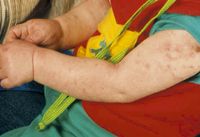- Case-Based Roundtable
- General Dermatology
- Eczema
- Chronic Hand Eczema
- Alopecia
- Aesthetics
- Vitiligo
- COVID-19
- Actinic Keratosis
- Precision Medicine and Biologics
- Rare Disease
- Wound Care
- Rosacea
- Psoriasis
- Psoriatic Arthritis
- Atopic Dermatitis
- Melasma
- NP and PA
- Skin Cancer
- Hidradenitis Suppurativa
- Drug Watch
- Pigmentary Disorders
- Acne
- Pediatric Dermatology
- Practice Management
- Prurigo Nodularis
- Buy-and-Bill
Article
Pediatric AD options a mixed bag
Miami — The bad news about pediatric atopic dermatitis (AD) is that it rarely reverses course completely. The good news is, doctors can largely control it through a variety of interventions.

In treating pediatric AD patients, physicians must first educate patients and their families regarding the fact that atopic children's skin is genetically programmed to be hyperreactive to its environment.
"We're probably not going to make a complete turnaround in this regard. So, in virtually all children, it's a fairly chronic condition. It's not like treating strep throat or an ear infection. But we can control it really well, and most children grow out of their AD as time goes on," says Howard B. Pride, M.D., associate professor, department of dermatology, Geisinger Medical Center, Danville, Pa.

"In terms of environmental control," Dr. Pride says, "food tends to be discussed a lot. Unfortunately, we don't have tests in this area that are 100 percent sensitive and specific. And, even if we did, trying to avoid every environmental allergen can be very difficult. However, for parents who are really keyed in on food, we can tell them that 85 percent of positive food challenges are to milk, eggs and peanuts."
As with foods, allergies to dust mites are difficult to pin down.
However, he says, "If the history suggests that exposure to dust tends to set a patient off, then there are some fairly simple things one can do without totally redoing the house - not having carpeting in bedrooms, covering pillows and mattresses and avoiding Venetian blinds and other items that collect dust, as well as vacuuming more frequently."
Managing difficult casesFor especially difficult cases, Dr. Pride prefers to bring in an allergist. More specifically, he feels more comfortable tapping an allergist's expertise when respiratory symptoms or rhinoconjunctivitis dominate, when parental history strongly suggests a cause-effect relationship with a particular allergen, or when parents persevere in hunting for a single trigger.
"If we get to a point where we're doing everything right in terms of treatment and not getting good results," he adds, "that's a good time to share the pain with an allergist as well."
Some patients also may benefit from the use of probiotics such as lactobacilli. To date, three blinded, placebo-controlled studies in which researchers gave such supplements either to pregnant or nursing mothers or their children with AD have shown statistically significant results compared to placebo (J Allergy Clin Immunol. 2003;111:389-395; J Allergy Clin Immunol. 2002;109:119-121; Lancet. 2001;357:1076-1079).
"In the United States," Dr. Pride says, "we're still struggling with this idea and are cautiously hopeful that it will help some of our patients."
Bathing also can help pediatric AD patients, but only if it's done correctly.
"The real key to bathing is getting a moisturizer on the skin, preferably within three minutes of coming out of the tub," he says.
In keeping with the preceding suggestion, emollients represent a mainstay of treatment, especially in dry winter months.






